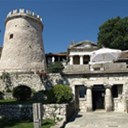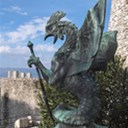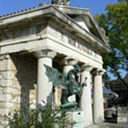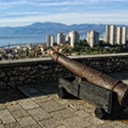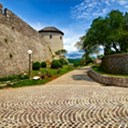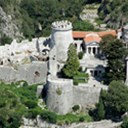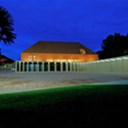Trsat
Mentioned for the first time in 799, Trsat is an ideal place for a walk, for having a coffee and sightseeing. Particularly the Trsat Castle which dates back to the prehistoric times when it was just a watchtower. Its present appearance is the merit of its last owner, Count Laval Nugent, who bought it in the first half of the 19th century, renovating it into a family mausoleum.
Nearby there is the Shrine of Our Lady of Trsat, one of the oldest in Croatia, that in June 2003 was visited by the Pope John Paul II. In his honour, the monument of The Holy Father –The Pilgrim of Trsat was built in the shrine, the work of the sculptor Ante Jurkić.
The Trsat Shrine, according to legend, was founded in 1291 when a small Nazareth house of the Holy Family appeared here, brought by angels… For seven centuries this has been the place frequented by numerous pilgrims from all around the world, however a particularly solemn occasion is on 15 August, during the Feast of the Assumption.
The shrine and the Franciscan Monastery are also connected with Rijeka’s city centre with Petar Kružić’s Steps, the construction of which was ordered by the Croatian warlord in 1531, which they were named after. There are a total of 561 steps of an enjoyable walk from the city centre to Trsat.
Be sure to visit the Trsat Park, made in the period between the two World Wars based on the project of the architect Zlatko Prikril and the horticulture expert Josip Kulfanek, known for the indigenous plants and for respecting the natural rocky landscape, as well as the cemetery.
And the last but not the least, the gastronomic offer of Trsat is excellent, so be sure to conclude your walk and sightseeing tour by some delicious food.
Enjoy the view that will leave you breathless, take a look at the permanent museum exhibition and the gallery and visit the souvenir shop and the café bar. If you come in the summer, here you can enjoy the evening concerts, theatre performances or outdoor fashion shows.
An unavoidable part of the Shrine of Our Lady of Trsat is the Chapel of Votive Gifts. The richness of this treasury reveals the miraculous powers and gratitude shown by the believers to Our Lady of Trsat. Here you can see the valuable donations of the Habsburg rulers – Leopold’s candlesticks and a two-headed golden eagle studded with gems, the symbol of Rijeka, a gift from Carl V.
